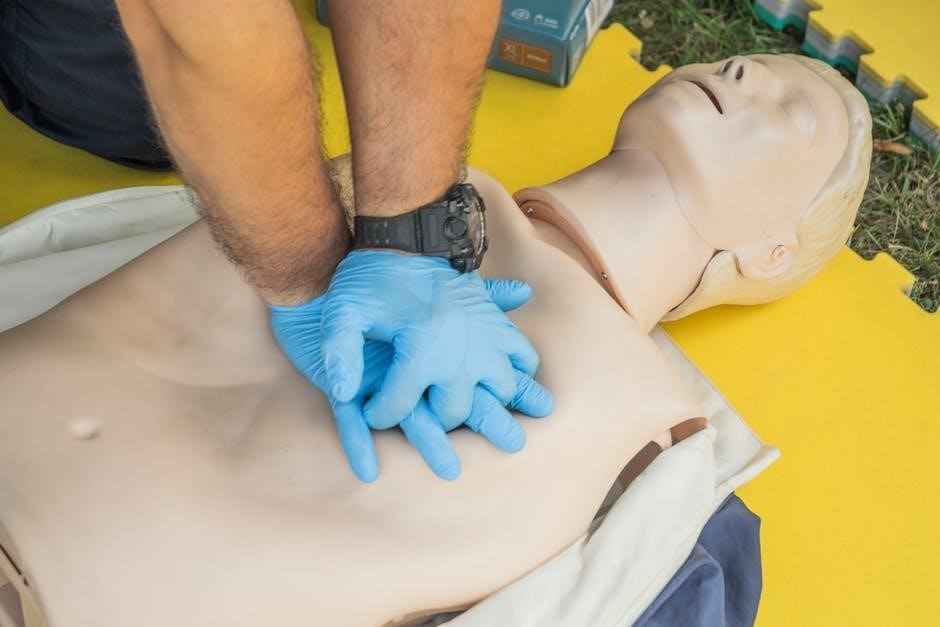Manual resuscitation involves chest compressions and ventilations to maintain blood circulation and oxygenation during cardiac arrest, crucial for restoring spontaneous circulation and improving survival chances.
1.1 Definition and Purpose of Manual Resuscitation
Manual resuscitation is a lifesaving technique involving chest compressions and rescue breaths to restore blood circulation and oxygenation during cardiac arrest. Its primary purpose is to maintain blood flow to vital organs, such as the brain and heart, until advanced medical help arrives. Continuous chest compressions, even by untrained bystanders, are critical to prevent tissue damage and improve survival chances. Manual resuscitation also includes ventilation to ensure adequate oxygen supply, synchronized with spontaneous breathing efforts when possible. The technique is essential for maintaining viability until definitive care, such as defibrillation or advanced life support, can be provided.
1.2 Historical Background of CPR Techniques
Manual resuscitation techniques have evolved significantly over centuries, with early practices focusing on bellows and mouth-to-mouth ventilation. Modern CPR emerged in the 1950s, combining chest compressions and rescue breaths. The development of external defibrillation and standardized training programs further refined the approach. Historical studies highlighted the importance of continuous chest compressions, leading to bystander CPR initiatives. Advances in ventilation techniques, such as synchronized breathing, improved outcomes. The shift from manual to mechanical CPR in some settings reflects ongoing research. These historical advancements have shaped current practices, emphasizing the critical role of immediate intervention in cardiac arrest scenarios to maximize survival and recovery chances.
Importance of High-Quality CPR
High-quality CPR restores spontaneous circulation, improves neurological function, and saves lives by maintaining blood flow and oxygenation to vital organs during cardiac arrest.
2.1 Role of Manual Resuscitation in Restoring Spontaneous Circulation (ROSC)
Manual resuscitation plays a critical role in restoring spontaneous circulation by maintaining blood flow and oxygen delivery to vital organs during cardiac arrest. High-quality chest compressions ensure adequate perfusion of the brain and heart, increasing the likelihood of successful ROSC. Continuous, uninterrupted compressions help preserve myocardial viability, while synchronized ventilations support oxygenation. The combination of these actions creates a temporary circulatory system, bridging the gap until advanced life support can be provided. Effective manual resuscitation significantly improves the chances of ROSC and subsequent survival, emphasizing the importance of proper technique and training.
2.2 Impact on Neurological Function and Survival Rates
Manual resuscitation significantly impacts neurological function and survival rates by maintaining cerebral blood flow and oxygenation during cardiac arrest. High-quality CPR prevents ischemic brain injury, reducing long-term neurological deficits. Studies show that uninterrupted chest compressions and proper ventilation improve survival rates and neurological outcomes. Timely and effective manual resuscitation minimizes brain damage, enhancing the likelihood of full recovery. The preservation of neurological function is directly linked to the quality and continuity of manual resuscitation efforts, emphasizing the importance of proper training and technique in saving lives and improving patient outcomes.

Manual vs. Mechanical CPR
Manual CPR relies on trained individuals for chest compressions and ventilations, while mechanical CPR uses devices for consistent, fatigue-free compressions, reducing rescuer error and improving outcomes.
3.1 Comparative Effectiveness of Manual and Mechanical CPR
Manual CPR, performed by trained rescuers, is effective but can vary in quality due to fatigue and human error. Mechanical CPR, using devices like automated chest compressors, provides consistent, high-quality compressions, reducing rescuer fatigue and improving hemodynamic stability. Studies show mechanical CPR can enhance restoration of spontaneous circulation (ROSC) and neurological outcomes in prolonged cardiac arrests. However, manual CPR remains more accessible and is often the first line of intervention. Both methods emphasize the importance of continuous chest compressions and proper ventilation synchronization. The choice between manual and mechanical CPR depends on resource availability, training, and the specific clinical scenario.
3.2 Studies and Evidence on CPR Methods
Recent studies, including an umbrella review and systematic reviews, compare manual and mechanical CPR effectiveness. Mechanical CPR, using devices like automated chest compressors, reduces rescuer fatigue and provides consistent compressions, improving hemodynamic stability. It is particularly beneficial in prolonged cardiac arrests, enhancing restoration of spontaneous circulation (ROSC) and neurological outcomes. Manual CPR, while effective, varies in quality due to human factors. Both methods emphasize continuous chest compressions and proper ventilation synchronization. The choice depends on resource availability, training, and clinical context. High-quality manual CPR remains crucial in initial response situations, while mechanical CPR offers advantages in specific scenarios, as supported by evidence from multiple studies.

Techniques of Manual Resuscitation
Manual resuscitation involves chest compressions at 100-120 per minute, allowing chest recoil, and providing 500-600 mL breaths. Proper technique ensures effective circulation and oxygenation during cardiac arrest.

4.1 Chest Compressions: Technique and Rate
Proper chest compressions involve placing the heel of one hand on the center of the chest, with the other hand on top, interlocking fingers. Compressions should be performed at a rate of 100-120 per minute, allowing full chest recoil between each compression. For adults, compressions should be 2-3 inches deep to ensure effective blood flow. Maintaining this technique and rate is critical for maximizing cardiac output during cardiac arrest. Continuous, uninterrupted compressions are essential, especially for untrained bystanders, until advanced help arrives. Proper hand positioning and consistent depth ensure the effectiveness of manual resuscitation efforts.
4.2 Ventilation: Synchronization with Spontaneous Breathing
Ventilation during manual resuscitation should be synchronized with the patient’s spontaneous breathing efforts to maintain control and avoid unnecessary interruptions. For assisted breathing, one breath should be delivered every 6 seconds, equating to 10 breaths per minute, each lasting about 1 second. Higher ventilation rates can lead to hemodynamic instability, potentially worsening the patient’s condition. When performing CPR, breath delivery should be asynchronous with chest compressions to ensure continuous blood flow. Proper synchronization helps maintain adequate oxygenation and minimizes complications, such as gastric inflation, especially when using devices like manually triggered, oxygen-powered resuscitators. This approach enhances the effectiveness of ventilation during cardiac arrest scenarios.
4.3 Combining Compressions and Breaths
Combining chest compressions and breaths is critical in manual resuscitation to maintain blood circulation and oxygenation. The cycle of compressions and breaths should continue uninterrupted, with each rescuer ideally being relieved every 2 minutes. Untrained bystanders should begin and maintain continuous chest compressions until professional help arrives, emphasizing the importance of pre-arrival instructions. When a defibrillator becomes available, it should be used promptly for patients in ventricular fibrillation or pulseless ventricular tachycardia. Synchronizing breaths with compressions ensures effective ventilation, while avoiding over-ventilation, which can cause hemodynamic instability. Proper coordination between compressions and breaths enhances the likelihood of restoring spontaneous circulation and improving patient outcomes during cardiac arrest.
Airway Management During Manual Resuscitation
Airway management is crucial for effective ventilation during CPR. Bag-mask devices and manually triggered, oxygen-powered resuscitators help maintain oxygenation while minimizing gastric inflation, ensuring proper ventilation techniques.
5.1 Use of Bag-Mask Devices
Bag-mask devices are essential for airway management during manual resuscitation, providing a reliable means of ventilation. They allow rescuers to deliver oxygen and breaths to patients who are not breathing or have an inadequate airway. Proper technique is critical to ensure effective ventilation and minimize complications such as gastric inflation. The device consists of a flexible mask that fits over the patient’s nose and mouth, connected to a bag that can be squeezed to deliver air. When used correctly, bag-mask devices help maintain adequate oxygenation and ventilation, supporting the patient’s respiratory needs until advanced airway management can be established. They are widely used in both in-hospital and out-of-hospital settings.
5.2 Manually Triggered, Oxygen-Powered Resuscitators
Manually triggered, oxygen-powered resuscitators are devices that deliver controlled ventilation during CPR. Unlike bag-mask devices, they use oxygen flow to inflate the lungs, reducing the risk of gastric inflation. Studies show that these resuscitators cause less gastric distension compared to bag-mask ventilation, particularly in patients without an advanced airway. They are recommended for use in scenarios where a mask is employed for ventilation and an advanced airway is not in place. These devices are classified as Class IIb, LOE C, indicating their potential benefit in specific situations. They are particularly useful for minimizing complications during manual resuscitation, ensuring more effective ventilation and better patient outcomes.
5.3 Avoiding Gastric Inflation
Avoiding gastric inflation is critical during manual resuscitation to prevent complications. Gastric inflation can lead to vomiting, aspiration, and reduced lung volume, compromising ventilation effectiveness. Proper technique with bag-mask devices, such as maintaining a sealed mask and using gentle pressure, minimizes stomach distension. Manually triggered, oxygen-powered resuscitators are advantageous as they deliver controlled ventilation, reducing gastric inflation risk. Studies indicate that these devices cause less gastric inflation compared to standard bag-mask ventilation, especially in patients without an advanced airway. Ensuring proper airway management and using appropriate devices helps maintain effective ventilation and prevents gastric complications, ultimately improving patient outcomes during CPR.

Role of Bystanders in Manual Resuscitation
Bystanders play a vital role in manual resuscitation by initiating continuous chest compressions and following pre-arrival instructions, significantly improving circulation and survival chances until professional help arrives.
6.1 Importance of Continuous Chest Compressions
Continuous chest compressions are critical during manual resuscitation to maintain blood circulation and oxygen supply to vital organs. They ensure perfusion of the brain and heart, reducing the risk of permanent damage. Even untrained bystanders should initiate compressions immediately, as delays can worsen outcomes. The American Heart Association recommends a compression rate of 100-120 per minute, allowing the chest to fully recoil between compressions. Rescuers should be relieved every 2 minutes to prevent fatigue and maintain effectiveness. Continuous compressions are vital until advanced life support arrives, emphasizing the bystander’s role in bridging the gap to professional care.
6.2 Pre-Arrival Instructions for Untrained Bystanders
Emergency response providers often give pre-arrival instructions to untrained bystanders, emphasizing the importance of starting and maintaining continuous chest compressions. These instructions typically focus on compressions-only CPR, as it is simpler for untrained individuals to perform effectively. Callers are guided to place the heel of one hand on the center of the chest and the other hand on top, interlocking fingers, and push to a depth of 2-3 inches at a rate of 100-120 compressions per minute. This immediate action can significantly improve survival rates by preserving organ function until professional help arrives. Bystanders are urged to continue uninterrupted compressions, relieving one another every 2 minutes to avoid fatigue.
Training and Guidelines for Manual Resuscitation
Standard CPR training programs emphasize evidence-based guidelines, focusing on proper techniques, compression rates, and ventilation synchronization to maximize the effectiveness of manual resuscitation efforts.
7.1 Standard CPR Training Programs
Standard CPR training programs are designed to equip individuals with the skills to perform high-quality manual resuscitation. These programs emphasize evidence-based guidelines, focusing on proper chest compression techniques, ventilation rates, and synchronization of breaths with compressions. Training often includes hands-on practice with mannequins to ensure proficiency in applying the correct force and rhythm. Many programs also cover the use of automated external defibrillators (AEDs) and manual defibrillators, as well as airway management techniques. The goal of these programs is to improve survival rates by ensuring that rescuers can maintain adequate blood circulation and oxygenation until advanced medical help arrives. Regular updates to guidelines are incorporated to reflect the latest research and best practices in resuscitation.
7.2 Updates in Resuscitation Guidelines
Resuscitation guidelines are continuously updated to reflect the latest research and advancements in manual resuscitation techniques. Recent updates emphasize minimizing manual hyperventilation to prevent hemodynamic instability, recommending asynchronous breath delivery during chest compressions. Tidal-volume feedback devices are now encouraged to monitor and optimize ventilation rates, ensuring breaths are delivered over one second. Studies comparing manual and mechanical CPR highlight the importance of maintaining high-quality compressions and proper synchronization. These updates aim to standardize techniques, reduce complications, and improve patient outcomes. Regular reviews of evidence ensure that guidelines remain aligned with best practices, providing rescuers with the most effective strategies for manual resuscitation.

Special Considerations in Manual Resuscitation
Manual resuscitation requires tailored approaches for pediatric, infant, and pregnant patients, as well as those with specific medical conditions, ensuring techniques adapt to unique physiological needs.
8.1 Pediatric and Infant Resuscitation
Manual resuscitation in pediatric and infant patients requires specialized techniques due to their smaller body size and unique physiological needs. Chest compressions must be adapted to ensure proper depth without causing harm. For infants, a two-finger technique is often used, while children may require one or two hands depending on their size. Ventilation rates and volumes must also be adjusted to prevent over-inflation or gastric inflation. Specialized devices, such as smaller bag-mask units, are essential for effective ventilation. Training programs emphasize the importance of recognizing pediatric cardiac arrest signs early and applying age-specific CPR protocols to maximize survival chances and neurological outcomes.

8.2 Resuscitation in Pregnant Women

Manual resuscitation in pregnant women requires careful consideration of physiological changes, such as increased blood volume and venous caval compression. Chest compressions must be performed with attention to the elevated diaphragm and abdominal pressure. Automated external defibrillators (AEDs) are safe and effective for use during pregnancy. Manual defibrillators may also be used, but with caution. Proper positioning, such as placing a wedge under the right shoulder, can improve venous return and cardiac output. Specialized training emphasizes recognizing pregnancy-related cardiac arrest causes and adapting CPR techniques to accommodate anatomical and physiological changes, ensuring the best possible outcomes for both mother and fetus.
8.3 CPR in Patients with Specific Medical Conditions
Manual resuscitation must be tailored to patients with specific medical conditions, such as trauma, burns, or severe respiratory distress. For trauma patients, CPR techniques may involve controlling bleeding while maintaining chest compressions. In burn victims, care is taken to avoid infection and ensure proper ventilation. Patients with severe respiratory conditions may require synchronized ventilation to prevent hyperventilation. Specialized training is essential to address these unique challenges effectively. Adaptations in technique and equipment, such as using manual defibrillators or oxygen-powered resuscitators, can improve outcomes. Continuous training and updated guidelines ensure healthcare providers are prepared to handle diverse medical scenarios during CPR.
Devices and Equipment in Manual Resuscitation
Manual resuscitation employs devices like manual defibrillators for ventricular fibrillation and automated external defibrillators for public use, alongside tools such as bag-mask devices and oxygen-powered resuscitators.
9.1 Manual Defibrillators in Ventricular Fibrillation (VF)
Manual defibrillators are critical in treating ventricular fibrillation (VF) and pulseless ventricular tachycardia (VT). These devices deliver an unsynchronized shock to restore a viable cardiac rhythm. Trained personnel operate them, ensuring proper electrode placement and energy dose. The sequence of therapies during resuscitation includes CPR followed by defibrillation. Manual defibrillators allow for precise control over shock delivery, making them essential in clinical settings. Their use is guided by resuscitation protocols, emphasizing timely intervention to maximize the chance of successful resuscitation and improved patient outcomes.
9.2 Use of Automated External Defibrillators (AEDs)
Automated External Defibrillators (AEDs) are portable devices designed to restore normal heart rhythm during cardiac arrest caused by ventricular fibrillation (VF) or pulseless ventricular tachycardia (VT). AEDs automatically diagnose abnormal heart rhythms and deliver an electric shock to correct them. They are user-friendly, requiring minimal training, making them accessible to bystanders and first responders. AEDs analyze the heart’s rhythm and provide voice or visual instructions, ensuring safe and effective use. Public access to AEDs has significantly improved survival rates, as they can be applied before professional medical help arrives. Their integration into resuscitation protocols emphasizes early defibrillation as a critical step in saving lives during cardiac emergencies.

Physiology of Ventilation During Cardiac Arrest
Ventilation during cardiac arrest maintains oxygenation and prevents hypercapnia, with breaths synchronized to compressions to avoid hemodynamic instability and ensure optimal blood flow distribution.
10.1 Hemodynamic Instability and Ventilation Rates
Ventilation rates during cardiac arrest significantly impact hemodynamic stability. Excessive ventilation can lead to increased intrathoracic pressure, reducing coronary and cerebral perfusion pressures. Studies suggest that ventilation rates exceeding 12 breaths per minute are associated with decreased likelihood of return of spontaneous circulation (ROSC). The American Heart Association recommends maintaining ventilation rates between 8-12 breaths per minute to optimize blood flow during CPR. Proper synchronization of breaths with chest compressions is crucial to avoid hemodynamic instability. Additionally, manual ventilation devices with tidal-volume feedback can help prevent over-ventilation, ensuring safer and more effective resuscitation efforts.
10.2 Minimizing Manual Hyperventilation
Manual hyperventilation during CPR can cause hemodynamic instability and reduce the likelihood of successful resuscitation. To minimize this, rescuers should deliver breaths asynchronously with chest compressions, ensuring one breath every 6 seconds. This approach prevents excessive intrathoracic pressure fluctuations, maintaining optimal blood flow. Additionally, using devices like tidal-volume feedback tools helps monitor and control ventilation rates, preventing overinflation. Training programs emphasize the importance of avoiding rapid or deep breaths, focusing instead on steady, controlled ventilation. These strategies aim to preserve cerebral and coronary perfusion, enhancing the chances of restoring spontaneous circulation and improving patient outcomes during cardiac arrest.

Future Directions in Manual Resuscitation
Advances in tidal-volume feedback devices and innovative CPR techniques aim to enhance resuscitation outcomes, ensuring more effective and accessible life-saving interventions in cardiac arrest scenarios.
11.1 Advances in Tidal-Volume Feedback Devices
Tidal-volume feedback devices are revolutionizing manual resuscitation by providing real-time measurements of ventilation volumes, helping rescuers avoid excessive ventilation. These devices, such as the Ambu resuscitation bag with a duck-bill valve, ensure precise air delivery and CO2 exhalation. By minimizing manual hyperventilation, they reduce the risk of hemodynamic instability and gastric inflation, especially in patients without advanced airways. Such innovations enhance the effectiveness of CPR, particularly in pre-hospital settings, and are increasingly recommended for improving ventilation management during cardiac arrest scenarios.
11.2 Innovations in CPR Techniques and Technologies
Recent advancements in CPR techniques and technologies aim to enhance the effectiveness of manual resuscitation. Improved chest compression devices now provide real-time feedback on compression depth and rate, ensuring adherence to guidelines. Automated external defibrillators (AEDs) with advanced algorithms improve shock delivery accuracy. Additionally, wearable technologies and mobile apps are being developed to guide bystanders in performing CPR correctly. These innovations, combined with updated training protocols, aim to increase the likelihood of successful resuscitation and improve survival rates. Such technological integration into manual resuscitation is transforming emergency response, making CPR more accessible and effective for both professionals and untrained individuals.
Conclusion
Manual resuscitation is a lifesaving technique that, when performed correctly, significantly improves survival rates and neurological outcomes during cardiac arrest, emphasizing the importance of proper training and technique.
12.1 Summary of Key Points
Manual resuscitation is a critical intervention during cardiac arrest, emphasizing chest compressions and ventilations to maintain circulation and oxygenation. High-quality CPR restores spontaneous circulation, improving survival and neurological outcomes. Bystanders play a vital role by initiating continuous compressions until professional help arrives. Devices like bag-mask and oxygen-powered resuscitators enhance ventilation, reducing gastric inflation risks. Studies show manual CPR remains effective, though mechanical CPR offers benefits in prolonged arrests. Proper training and adherence to guidelines are essential for optimal results. Advances in tidal-volume feedback devices and techniques aim to minimize hyperventilation, further improving outcomes. Continuous updates in resuscitation methods highlight the evolving nature of this lifesaving practice.
12.2 Final Thoughts on the Importance of Manual Resuscitation
Manual resuscitation remains a cornerstone of cardiac arrest management, offering a lifeline by maintaining circulation and oxygenation. Its simplicity and immediacy make it accessible to both trained professionals and untrained bystanders, emphasizing the critical role of continuous chest compressions. The integration of devices like bag-mask and oxygen-powered resuscitators enhances ventilation quality, reducing complications. High-quality CPR not only restores spontaneous circulation but also preserves neurological function, significantly improving survival rates. As techniques and technologies evolve, the foundational principles of manual resuscitation endure, underscoring its indispensable role in saving lives during critical moments.
